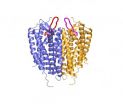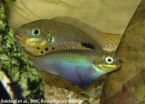Scientists give extinct passenger pigeon a place on the family tree
DNA analysis reveals that the extinct bird's closest relative is a common California resident
2010-10-08
(Press-News.org) With bits of DNA extracted from century-old museum specimens, researchers have found a place for the extinct Passenger Pigeon (Ectopistes migratorius) in the family tree of pigeons and doves, identifying this unique bird's closest living avian relatives for the first time. The new analysis, which appears this month in Molecular Phylogenetics and Evolution, reveals that the Passenger Pigeon was most closely related to other North and South American pigeons, and not to the Mourning Dove, as was previously suspected.
"This research demonstrates the remarkable potential of DNA to answer questions about species that no longer populate our planet," says Dr. Jack Dumbacher, Curator of Ornithology at the California Academy of Sciences. "The Passenger Pigeon has been extinct for almost 100 years, but with the help of museum specimens and DNA analysis, we're still learning new information about the bird's evolutionary history and its place on the tree of life."
Naturalists have long lamented that one of North America's most spectacular birds was also one of the first to be driven to extinction by humans. In the early 1800s, the Passenger Pigeon was the most abundant bird species on the planet, even though its range was limited to the eastern and central forests of the United States and parts of eastern Canada. Flocks of Passenger Pigeons included millions of birds—they were so vast that they darkened swaths of the sky up to a mile wide.
Passenger Pigeons followed their food, settling down in forests that periodically produced a superabundance of acorns and chestnuts. The pigeons nested in dense colonies covering hundreds of acres. This made them easy targets for human predators. Intensive pigeon hunting in the mid-to-late 19th century disrupted the birds' ability to breed. These hunting sprees, coupled with habitat destruction, rapidly drove the Passenger Pigeon to extinction. (The last of her kind, a Passenger Pigeon named Martha, died in the Cincinnati Zoo in 1914.)
To find the Passenger Pigeon's place in the evolutionary history of pigeons and doves, Dumbacher and his colleagues compared sequences from two of its mitochondrial genes with those of 78 species of pigeons and doves from around the world. Their analysis revealed a surprising result. Most scientists had assumed that the Passenger Pigeon's closest relative was the Mourning Dove, a smaller species that shared the Passenger Pigeon's relatively long tail. However, the DNA comparison showed that the extinct bird's closest living relative is the Band-Tailed Pigeon (Patagioenas fasciata), a bird that is commonly found in California.
North America's largest pigeon, the Band-Tailed Pigeon is distinguished not only by its large size but by its distinctive coloring, with yellow legs, a patch of iridescent greenish-bronze feathers on its neck, and a yellow bill with a black tip. Despite its large size, the bird is surprisingly adept at feeding on berries and seeds in the tops of trees. In northern California, it is found in mixed evergreen forests and redwood forests.
INFORMATION:
The research team was lead by Kevin Johnson, an ornithologist with the Illinois Natural History Survey at the University of Illinois. Additional team members included Jack Dumbacher from the California Academy of Sciences, Dale Clayton from the University of Utah, and Robert Fleischer from the Smithsonian Conservation Biology Institute. The research was funded by the National Science Foundation.
About the California Academy of Sciences:
The California Academy of Sciences is the only institution in the world to combine a museum, aquarium, planetarium, and world-class research and education programs under one roof. This unique combination allows visitors to explore the depths of a Philippine coral reef, climb into the canopy of a Costa Rican rainforest, and fly to the outer reaches of the Universe—all in a single visit. Designed by award-winning architect Renzo Piano, the building sets a new standard for sustainable architecture. It also provides a home for the Academy's research scientists, who launch dozens of expeditions each year to document biodiversity around the world, as well as the museum's 26 million research specimens—essential tools for comparative studies on the history and future of life on Earth.
The California Academy of Sciences is home to Steinhart Aquarium, Morrison Planetarium, Kimball Natural History Museum, and world-class research and education programs—all under one living roof. Admission to the Academy is: $29.95 for adults; $24.95 for youth ages 12 to 17, Seniors ages 65+ and students with valid ID; $19.95 for children ages 4 to 11; and free for children ages 3 and younger. The Academy is free to the public on the third Wednesday of each month. Admission fees include all exhibits and shows. Hours are 9:30 am – 5:00 pm Monday – Saturday, and 11:00 am – 5:00 pm on Sunday. The Academy is closed on Thanksgiving and Christmas. During peak periods, including some holiday weekends, an admission surcharge and extended hours may apply. Visit www.calacademy.org or call (415) 379-8000 for more information.
ELSE PRESS RELEASES FROM THIS DATE:
2010-10-08
LOS ANGELES (Oct. 6, 2010) – Cardiac imaging researchers at Cedars-Sinai Heart Institute are recommending that physicians not overlook fatty deposits around the heart when evaluating patients for risk of major heart problems.
Although abdominal fat is often considered in making these assessments, recent research suggests that measuring fatty tissue around the heart is an even better predictor, and noninvasive CT scanning may provide this important information.
The recommendation appeared in an editorial comment published in the Journal of the American College of Cardiology: ...
2010-10-08
There is still time to save the world's ailing coral reefs, if prompt and decisive action can be taken to improve their overall health, leading marine researchers say.
Writing in the journal Trends in Ecology and Evolution, eminent marine scientists from Australia and the USA have called for an international effort to improve the resilience of coral reefs, so they can withstand the impacts of climate change and other human activities.
"The world's coral reefs are important economic, social and environmental assets, and they are in deep trouble. How much trouble, and ...
2010-10-08
New York, NY, October 6, 2010 – In recognition of the 20th anniversary of the enactment of the Americans with Disabilities Act (ADA), the October issue of Disability and Health Journal has brought together a series of articles to examine whether the ADA has in fact improved the health of people with disabilities. Areas of progress are identified, most notably acknowledging physical barriers and need for better staff training and communication about and with people with disabilities. However, there continue to be ongoing challenges, including recurrent barriers to health ...
2010-10-08
STANFORD, Calif. - An alarming number of adolescents already battling eating disorders are also intentionally cutting themselves, and health-care providers may be failing to diagnose many instances of such self-injury, according to a new study from Stanford University School of Medicine and Lucile Packard Children's Hospital.
The researchers found that 40.8 percent of patients with eating disorders in their study had documented incidents of intentionally harming themselves, most often by cutting and burning. What's more, the study suggests that inadequate clinical screening ...
2010-10-08
Transgenic corn's resistance to pests has benefitted even non-transgenic corn, a new study led by scientists from the University of Minnesota shows.
The study, published in the Oct. 8 edition of the journal Science, found that widespread planting of genetically modified Bt corn throughout the Upper Midwest has suppressed populations of the European corn borer, historically one of corn's primary pests. This areawide suppression has dramatically reduced the estimated $1 billion in annual losses caused by the European corn borer, even on non-genetically modified corn. Bt ...
2010-10-08
LA JOLLA, CA – October 4, 2010 – Researchers have determined the structure of a protein that helps guide blood-forming stem cells, or hematopoetic stem cells. The protein is also one of the main receptors used by the human immunodeficiency virus (HIV) to get inside blood cells.
The findings are described in the October 7, 2010 issue of the journal Science.
The structure offers a detailed view of how the cell surface receptor, called CXCR4, interacts with molecules outside the cell. The results have implications for developing new drugs for hematopoetic stem cell transplantation, ...
2010-10-08
VIDEO:
This model shows how HIV, in gray, might latch on to immune cell receptor molecules, allowing the virus to enter and infect the cell. The viral protein, gp120, shown in...
Click here for more information.
In a technical tour de force, structural biologists funded by the National Institutes of Health have determined the three-dimensional structure of a molecule involved in HIV infection and in many forms of cancer. The high-resolution structure sheds light on how the ...
2010-10-08
Washington, DC/Beijing, China (7-8 October 2010)—A new study released today in Washington, DC and Beijing suggests that one of the world's largest and "greenest" paper companies, in concert with local officials and other middlemen, used illegal means to gain control over thousands of hectares of Chinese forestlands, with a goal of acquiring 120 thousand hectares for a eucalyptus plantation in the Guangxi Autonomous Region of southern China.
The authors say their research shows that the middlemen, acting on behalf of Finnish paper and pulp manufacturer Stora Enso, often ...
2010-10-08
For the first time, biologists have described the evolution of the size of a female trait which males use to choose a partner. The research, published in the open access journal BMC Evolutionary Biology, shows that male cichlid fish prefer females with a larger pelvic fin and that this drives females to grow fins out of proportion with their body size.
Sebastian Baldauf from the University of Bonn, Germany, worked with a team of researchers to study the effects of female ornamentation in the African cichlid fish Pelvicachromis taeniatus. He said, "In contrast to the ...
2010-10-08
Ultrasound can speed the healing of fractures. A randomized controlled trial reported in the open access journal BMC Musculoskeletal Disorders has found that the use of low-intensity pulsed ultrasound (LIPUS) in patients with tibial fractures which showed inadequate progress toward healing resulted in 34% greater bone mineral density (BMD) in the fracture area after 16 weeks than use of a sham device.
Jon E. Block, Ph.D. worked with a team of researchers from University Hospital Marburg and the University of Ulm, Germany, to test LIPUS in 51 patients and 50 controls. ...
LAST 30 PRESS RELEASES:
[Press-News.org] Scientists give extinct passenger pigeon a place on the family tree
DNA analysis reveals that the extinct bird's closest relative is a common California resident

